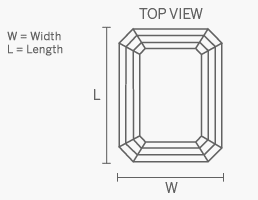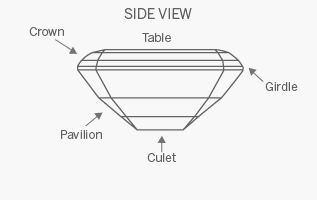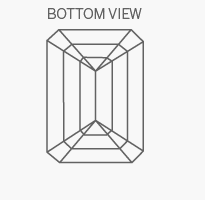Emerald Cut Diamonds Shape
The Essential 7C's
Every diamond has its own story, and every lady her own style.
At this point it should be noted that the shape of a diamond can also be referred to as its “cut"", like a round or princess cut. However, this should not be confused with the more commonly used term of diamond cut, which describes how well the diamond has been polished from the raw material (see section on diamond cut).
At Seventy Seven Diamonds we cater to the detailed wishes of every customer and want to ensure that they are well-informed about every diamond shape available. Our selection of beautiful shapes is accompanied by detailed information, images and recommendations on the uniqueness, the history and background, and the ideal ratio of every cut.
Emerald Cut Diamonds
1. The Basics | 2. Features | 3. Expert Advice | 4. History
1. The Basics
Also referred to as: SQUARE EMERALD CUT

| Unique Features |
Facets |
L/W Ratio |
Origin |
Expert Tip |
| Broad flat pane, truncated corners, step cut. |
Usually 57; varies depending on number of rows on crown and pavilion. |
Typically 1.30-1.50 (depending on taste) |
Evolved from table cuts 20th Century. |
Clarity VS1/VS2 and higher is optimal. |
2. Features



One of the first cuts to be used in jewellery, the emerald cut is a rectangular shape with truncated corners and a broad and flat plane that resembles stair steps when viewed from above. This style is referred to as a ‘step cut’. The emerald is usually comprised of 57 facets (with 25 on the crown and 32 on the pavilion), although the number of rows of facets on both the crown and pavilion can vary, altering the total number of facets for this cut.
While it typically has less fire and brilliance than brilliant cuts, the broad flat plane of this shape highlights the clarity of a diamond and its natural crystalline rectangular growth. Additionally, the flat planes of the edges allow for a variety of side gemstones such as the long thin rectangular diamonds that often flank this cut, known as baguettes.
The vast majority of emerald cuts have length to width ratios between 1.30 and 1.50 with 1.40 considered as the "ideal" or most popular. Those who prefer a more squared shape will opt for lower ratios while those after a more rectangular cut will choose higher ratios. Emerald ratios outside this range are atypical and generally less desirable.
3. Expert Advice
"Because of its large open facets, higher clarity grades (VS2 and above for GIA and VS1 and above for EGL, to ensure it is completely eye clean) are usually recommended for emerald cut diamonds.
As with the Asscher and Cushion cuts, more rectangular shapes (larger ratios) help to elongate shorter fingers."
4. History & Background
The exact origins of the first emerald cut remain somewhat ambiguous, although its stylistic specifications can be traced back to the single table cuts of some 500 years ago and the multi-faceted table cuts of the Art Deco period in the early 20th century.
The term “emerald cut"" only began being used during the Art Deco period, despite the fact that diamond cutters were already cutting the same shape under different names. Initially, the cut itself was developed specifically for emerald gems in order to reduce the amount of pressure exerted during cutting and to protect the gemstone from chipping. However, diamond cutters soon realized the importance of this cut and applied it to diamonds as well.

Where next?
To view emerald cut diamonds offered by Seventy Seven Diamonds, please click here.
To customise your emerald cut engagement ring, please click here.
If you would like to read more about diamond education, please click here.